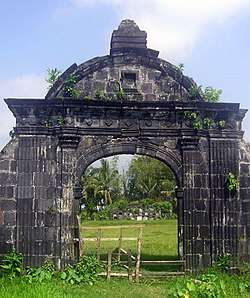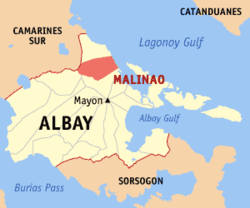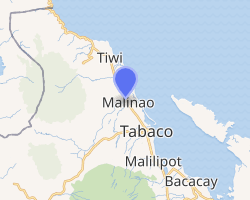Malinao, Albay
Malinao, officially the Municipality of Malinao (Central Bicolano: Banwaan kan Malinao; Tagalog: Bayan ng Malinao), is a 3rd class municipality in the province of Albay, Philippines. According to the 2015 census, it has a population of 45,301 people.[3]
Malinao | |
|---|---|
| Municipality of Malinao | |
 Spanish-era cemetery of Malinao | |
 Map of Albay with Malinao highlighted | |
OpenStreetMap 
| |
.svg.png) Malinao Location within the Philippines | |
| Coordinates: 13°24′N 123°42′E | |
| Country | |
| Region | Bicol Region (Region V) |
| Province | Albay |
| District | 1st district |
| Barangays | 29 (see Barangays) |
| Government | |
| • Type | Sangguniang Bayan |
| • Mayor | Lenybelle C. Santos |
| • Vice Mayor | Sheryl C. Bilo |
| • Congressman | Edcel C. Lagman |
| • Electorate | 32,006 voters (2019) |
| Area | |
| • Total | 107.50 km2 (41.51 sq mi) |
| Population (2015 census)[3] | |
| • Total | 45,301 |
| • Density | 420/km2 (1,100/sq mi) |
| • Households | 9,748 |
| Economy | |
| • Income class | 3rd municipal income class |
| • Poverty incidence | 27.54% (2015)[4] |
| • Revenue (₱) | 100,967,665.79 (2016) |
| Time zone | UTC+8 (PST) |
| ZIP code | 4514 |
| PSGC | |
| IDD : area code | +63 (0)52 |
| Climate type | tropical rainforest climate |
| Native languages | Central Bikol Albay Bikol language Tagalog |
| Website | www |
History
Malinao was founded in 1600, or 79 years after Ferdinand Magellan landed in Cebu and planted the first Christian Cross.
Between 1600 and 1616, Malinao was then part of the Diocese of Cagsawa (now Daraga). It became an independent bisita or sitio attached to Sawangan (now Legazpi City) until 1619, when separate religious administration was exercised with Rev. Francisco de Santa Ana, OFM, as first pastor.
Local folklore speaks of a plant once rich in this town called "alinao." The prefix "ma," which denotes abundance of something in local dialect, was affixed by the natives in referring to the place abundant with Alinao, thus Ma-alinao and later corrupted to Malinao.
It was in 1916 when, according to legendary account, Malinao got its name. A siege by Moros on town resulted in the abduction of seven women. Miraculously, the boat sank within the jurisdictional waters of Malinao and on that same spot in the sea across the island of natunawan because of the women's fervent prayer in canticles and "tarahades" or clear thoughts for the Blessed Virgin to sink the boat. From these "clear thoughts" of the seven women translated in Bicol dialect as "malinao na isip." The name of Malinao was given to the Municipality. It has since then the tradition among the residents particularly the women, to sing the canticles or tarahades in times of crisis, calamities, or when they want to drive away epidemics and misfortunes.
Geography
According to the Philippine Statistics Authority, the municipality has a land area of 107.50 square kilometres (41.51 sq mi) [2] constituting 4.17% of the 2,575.77-square-kilometre- (994.51 sq mi) total area of Albay.
Malinao occupies a narrow stretch of plains hemmed in by the Lagonoy Gulf in the east and Mount Malinao on the west. The area is dominated by the mountain ranges of Malinao, with a peak altitude of 1,584 metres (5,197 ft) above sea level.
The town is 587 kilometres (365 mi) south-east of Manila, 32 kilometres (20 mi) north of Albay Provincial Capitol, and 5 kilometres (3.1 mi) north of Tabaco City.
Land use
- Public land: 72.60 hectares (179.4 acres)
- Built-up/Residential: 985.76 hectares (2,435.9 acres)
- Agricultural: 5,750.34 hectares (14,209.4 acres)
- Irrigable: 2,250 hectares (5,600 acres)
- Irrigated: 1,873 hectares (4,630 acres)
- Forest: 1,569.30 hectares (3,877.8 acres)
- Timberland: 21.00 hectares (51.9 acres)
- 2nd growth: 615.00 hectares (1,519.7 acres)
- Watershed: 870.00 hectares (2,149.8 acres)
- Mangrove/swamp: 63.30 hectares (156.4 acres)
- Grassland/Shrub/Pasture: 15.00 hectares (37.1 acres)
- Idle/Vacant lot: 49.00 hectares (121.1 acres)
- Nipas: 2,308.00 hectares (5,703.2 acres)
Barangays
Malinao is politically subdivided into 29 barangays.[5] Of these, 12 are upland barangays, 13 lowland barangays, and 4 are coastal barangays. Twenty-five barangays are rural areas and the remaining four are urban.
| PSGC | Barangay | Population | ±% p.a. | |||
|---|---|---|---|---|---|---|
| 2015[3] | 2010[6] | |||||
| 050510001 | Awang | 0.8% | 347 | 336 | 0.62% | |
| 050510002 | Bagatangki | 1.7% | 772 | 569 | 5.98% | |
| 050510022 | Bagumbayan | 1.7% | 788 | 699 | 2.31% | |
| 050510003 | Balading | 6.9% | 3,104 | 2,996 | 0.68% | |
| 050510004 | Balza | 4.6% | 2,084 | 2,061 | 0.21% | |
| 050510005 | Bariw | 3.4% | 1,524 | 1,353 | 2.29% | |
| 050510006 | Baybay | 3.8% | 1,730 | 1,647 | 0.94% | |
| 050510007 | Bulang | 2.3% | 1,028 | 864 | 3.36% | |
| 050510008 | Burabod | 1.8% | 837 | 836 | 0.02% | |
| 050510009 | Cabunturan | 1.3% | 577 | 681 | −3.11% | |
| 050510010 | Comun | 3.9% | 1,772 | 1,672 | 1.11% | |
| 050510011 | Diaro | 2.0% | 889 | 885 | 0.09% | |
| 050510012 | Estancia | 9.5% | 4,293 | 3,987 | 1.42% | |
| 050510013 | Jonop | 4.5% | 2,024 | 2,009 | 0.14% | |
| 050510014 | Labnig | 7.7% | 3,479 | 3,410 | 0.38% | |
| 050510015 | Libod | 2.4% | 1,065 | 949 | 2.22% | |
| 050510016 | Malolos | 1.9% | 856 | 785 | 1.66% | |
| 050510017 | Matalipni | 4.3% | 1,939 | 1,863 | 0.76% | |
| 050510018 | Ogob | 4.4% | 1,992 | 1,975 | 0.16% | |
| 050510019 | Pawa | 2.7% | 1,217 | 1,103 | 1.89% | |
| 050510020 | Payahan | 3.1% | 1,414 | 1,390 | 0.33% | |
| 050510021 | Poblacion | 1.5% | 657 | 570 | 2.74% | |
| 050510023 | Quinarabasahan | 1.8% | 821 | 735 | 2.13% | |
| 050510024 | Santa Elena | 2.5% | 1,133 | 1,018 | 2.06% | |
| 050510025 | Soa | 3.0% | 1,352 | 1,248 | 1.54% | |
| 050510026 | Sugcad | 3.9% | 1,784 | 1,615 | 1.91% | |
| 050510027 | Tagoytoy | 5.1% | 2,323 | 2,217 | 0.89% | |
| 050510028 | Tanawan | 3.8% | 1,739 | 1,638 | 1.15% | |
| 050510029 | Tuliw | 3.9% | 1,761 | 1,659 | 1.14% | |
| Total | 45,301 | 42,770 | 1.10% | |||
Climate
| Climate data for Malinao, Albay | |||||||||||||
|---|---|---|---|---|---|---|---|---|---|---|---|---|---|
| Month | Jan | Feb | Mar | Apr | May | Jun | Jul | Aug | Sep | Oct | Nov | Dec | Year |
| Average high °C (°F) | 27 (81) |
27 (81) |
28 (82) |
30 (86) |
31 (88) |
30 (86) |
29 (84) |
29 (84) |
29 (84) |
29 (84) |
28 (82) |
27 (81) |
29 (84) |
| Average low °C (°F) | 22 (72) |
22 (72) |
23 (73) |
24 (75) |
25 (77) |
25 (77) |
25 (77) |
25 (77) |
25 (77) |
24 (75) |
24 (75) |
23 (73) |
24 (75) |
| Average precipitation mm (inches) | 138 (5.4) |
83 (3.3) |
74 (2.9) |
50 (2.0) |
108 (4.3) |
165 (6.5) |
202 (8.0) |
165 (6.5) |
190 (7.5) |
186 (7.3) |
188 (7.4) |
183 (7.2) |
1,732 (68.3) |
| Average rainy days | 16.8 | 11.9 | 13.5 | 13.8 | 20.5 | 25.2 | 27.4 | 26.2 | 26.1 | 24.7 | 20.7 | 18.5 | 245.3 |
| Source: Meteoblue [7] | |||||||||||||
Demographics
|
| ||||||||||||||||||||||||||||||||||||||||||||||||
| Source: Philippine Statistics Authority[3][6][8][9] | |||||||||||||||||||||||||||||||||||||||||||||||||
In the 2015 census, Malinao had a population of 45,301.[3] The population density was 420 inhabitants per square kilometre (1,100/sq mi).
In 1995, The total population was 33,872, which increased by 2359 individuals or 6.94% for five (5) years in 2000. In the 2010 census, the population had reached 42,770.
Of these, less than ten (10) percent or 3,301 reside in the urban barangays of Bagumbayan, Pawa, Payahan, and Poblacion. The rest of the constituents meanwhile stay on the rural barangays: Awang, Bagatangki, Balading, Balza, Bariw, Baybay, Bulang, Burabod, Cabunturan, Comun, Diaro, Estancia, Jonop, Labnig, Libod, Malolos, matalipni, Ogob, Quinarabasahan, Santa Elena, Soa, Sugcad, Tagoytoy, Tanawan, and Tuliw. The densest areas are Estancia, Labnig, and Balading while Awang and Bagatangki are the least populated in the rural areas.
The majority of its population is engaged in agriculture and other agri-related enterprise.
Economy
The major agricultural products are:
- Palay
- Irrigated: 3,709.44 hectares (9,166.2 acres) - 11,754.00 MT
- Rainfed: 635.35 hectares (1,570.0 acres) - 1,992.90 MT
- Abaca: 1,260 hectares (3,100 acres) - 252.00 MT
- Coconut: 186 hectares (460 acres) - 54.87 MT
Other crops:
- Camote: 4.85 hectares (12.0 acres) - 48.50 MT
- Cassava: 3.77 hectares (9.3 acres) - 45.50 MT
- Gabi: 1.50 hectares (3.7 acres) - 4.50 MT
- Vegetable (leafy): 5.193 hectares (12.83 acres) - 9.049 MT
- Fruit vegetable: 21.869 hectares (54.04 acres) - 93.95 MT
- Fruits: 36.29 hectares (89.7 acres) - 229.4 MT
- Sugarcane: 10 hectares (25 acres) - 0.84 MT
References
- "Municipality". Quezon City, Philippines: Department of the Interior and Local Government. Retrieved 31 May 2013.
- "Province: Albay". PSGC Interactive. Quezon City, Philippines: Philippine Statistics Authority. Retrieved 12 November 2016.
- Census of Population (2015). "Region V (Bicol Region)". Total Population by Province, City, Municipality and Barangay. PSA. Retrieved 20 June 2016.
- "PSA releases the 2015 Municipal and City Level Poverty Estimates". Quezon City, Philippines. Retrieved 1 January 2020.
- "Municipal: Malinao, Albay". PSGC Interactive. Quezon City, Philippines: Philippine Statistics Authority. Retrieved 8 January 2016.
- Census of Population and Housing (2010). "Region V (Bicol Region)". Total Population by Province, City, Municipality and Barangay. NSO. Retrieved 29 June 2016.
- "Malinao, Albay : Average Temperatures and Rainfall". Meteoblue. Retrieved 29 December 2018.
- Censuses of Population (1903–2007). "Region V (Bicol Region)". Table 1. Population Enumerated in Various Censuses by Province/Highly Urbanized City: 1903 to 2007. NSO.
- "Province of Albay". Municipality Population Data. Local Water Utilities Administration Research Division. Retrieved 17 December 2016.
External links

- Malinao Profile at PhilAtlas.com
- Philippine Standard Geographic Code